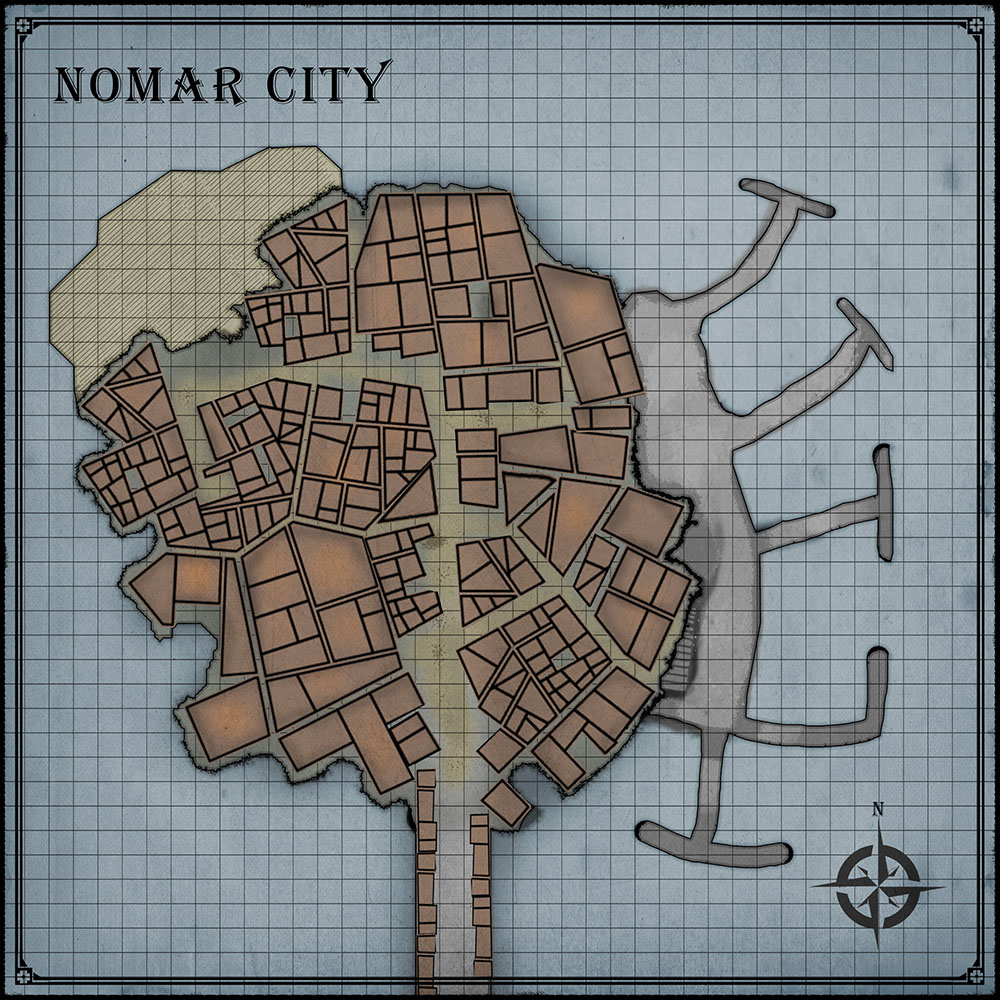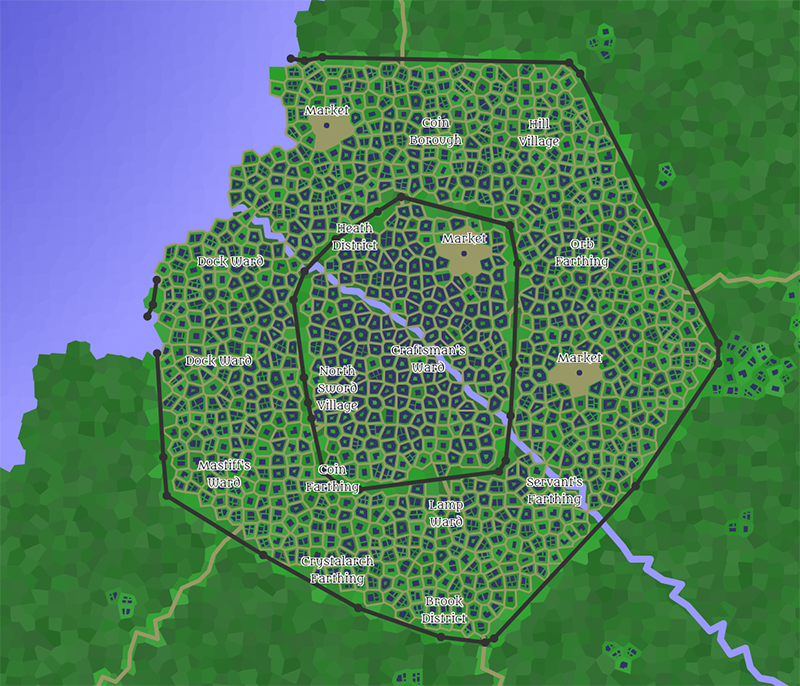Building Cities & Towns in D&D
- 21.08.2019
- Nathan
Building an entire city town or village for your fantasy game can seem very daunting at first, but can also be one of the most fulfilling parts of your worldbuilding adventure. This is where the people of your story live and where your players will first explore. It's where the lore and storytelling take shape in a way previously untouched.
In my previous post, I showed you the world of Elara created for my own game. In this post, I will focus on 1 created for this world, on a portion of coastline from which the story began. I will show what was created and what needs improvement having run an adventure there.
For nearly all locations NPC's and lots of other stuff I used Fantasy Name generator, it's a great resource for those needing inspiration.
Nomar City
Nomar City sat upon a sea stack on the east coast of the continent. It served as a trading post between the continents as it hosted a dock for boats and airships. I was quite pleased with how this location turned out, but once again was really far too small to have earned the trade and lawlessness prestige that I had given it at the time. In this post, I will show the creative process and how I intend to update and expand it into something great.
At some point in my adventure, my players were tasked with finding transport to the eastern continent of Metis. It made sense for the city to be founded on trade and would also need to be defensible like many settlements, not only from monsters, but pillagers looking for valuable foreign goods. To meet this criterion and for a unique flavour, I decided to set this city on top of a huge sea stack connected to the mainland via a man-made stone bridge. On the other side of the bridge was a small settlement named Willowsdale. Another key part of the city was a sense of lawlessness where vigilante groups decided what goes and what doesn't.

Looking back on this city there are sever aspects I'm quite happy with, but also loads that don't make sense. Why a city so small be this famous trading post? Why isn't Willowsdale part of the city and what realistic connections fo they have? Why would a seemingly uncivilized lawless city host an airship dock?
The great thing about expanding on ideas already put out into the world is that you're only a simple time skip away from changing reality. It should be noted, just because what was known before doesn't seem realistic doesn't mean it should be redacted. If it's interesting or fun, simply find a way to make it fit the narrative!
For nearly all of my local maps, I used an awesome tool called medieval fantasy city generator. It appears to have had many updates since I last used it too! Sometime I would take those maps into photoshop to make something more unique and to add flourishes, other times it was good enough as is. I used this technique for Nomar's map as seen below.

One of the first major changes is to expand the city onto the mainland, taking over space once occupied by Willowsdale and splitting the city into 2 parts, one on the sea stack and one on land. This creates a natural point of contention between each part of the city. The geography would dictate that the sea stack will be home to most business ventures and trading, whilst the areas on land will house the majority of the population. The rich who are able to live on the stack control a vast majority of the wealth in the city, which goes some way as to explain the juxtaposition of a depraved population and the advanced airship docking platform.
The other major change will be to introduce more groups of power into the mix. This will also affect the greater world as we can create factions that have followers in many places. The only real existing group in the city are known as the officers, self-appointed guards of sorts who decide what they think is right and wrong. They demand a tax from the people who live in the city in return for protection.
After creating the geography of your settlement, choosing a location on your map and integrating it into the surrounding area, you need to choose some key landmarks. These could be many things from large buildings, geographical features like mountains and rivers to city districts. Then, on a more granular level you should consider the following:
Religious buildings - What deities are the population likely to worship. Some of them may be inspired by the race and alignment and location of the population.
Taverns, shops & markets - Most cities have taverns and general stores that cater to adventurers and common folk. Blacksmiths, woodworkers, herbalists and tanners are among the most common trades needed. Many businesses in your city will offer flavour even if they don't trade with the players. In Nomar, an open market brazenly trades slaves on the streets, an unavoidable grim reality the players won't fail to notice.
Housing - Where does the mass of the population live? This is the easiest way to pad out the size of a city and will account for most of the buildings. You will also consider who lives in each part of the city. Is there a divide between rich and poor? Religous and unhallowed?
Transportation - How do most people arrive in your city. Roads and docks are the most common answer, but perhaps your running more high-tech game with plentiful airships and railways. Think about how people are able to travel to the most visited locations unimpeded, or perhaps the small ancient paths of your town are an encumbrance to modern life.
Populating the city can be time-consuming and sometimes, without careful consideration, can become cookie cutter. Donjon's random town generator is great for generating maps, but also provides details for padding out the services of the city with random entities and can be used as a checklist of sorts. It's great for inspiration if your struggling with the process thus far.

We can easily update the narrative to account for changes to locations once visited. Nomar may be split into 2 wards. "The Stack" and "The Willow". As the city expands further onto land, the poor folk living on the stack were forced onto mainland as the land value of the stack increases, paving the way for business to thrive between traders on the stack. A few of the richest families of the city remain on the stack and have gained control over most of the activities there.
The officers are now employed solely on the stack and are in the pockets of the noble business owners who live there. They appear to be little more than hired thugs, but they patrol in large quantity and are good at keeping the peace, in a barbaric way.
The Willow is not as well policed yet is generally quite safe for those who live there and only poses a mild threat to visitors. After all, the locals don't want trouble in their backyard. Some protection is offered by those who are part of factions* that look out for each other and may even have noble intentions of turning the cities alignment around.
*Factions that belong throughout the continent of Ozryn and the wider world will be covered in another post as we walk through the creation process.
Below is the grisly city as described from the perspective of players arriving via boat.
You arrive at the docks of the city and you’re greeted with some grim views. The docks are made from partially carved, partially natural rock formations that are slick with seawater. The city stands around 100ft above you on a sea stack. Steep carved steps climb up the side of the rock and looking up you see iron ladders and winches.
Dockworkers are hauling goods up to the cliff's surface from which iron cages dangle from chains. Inside are what looks like huddled over humanoid cadavers. It's hard to tell if any of them are living, but the smell in the air reeks of death nonetheless.
In the next post, we will explore the destination of my first adventure, the civilised capital city of Celestrium. We will discuss its lore that gives the world greater meaning and the NPC's that call it home and the internal struggles it faces.



